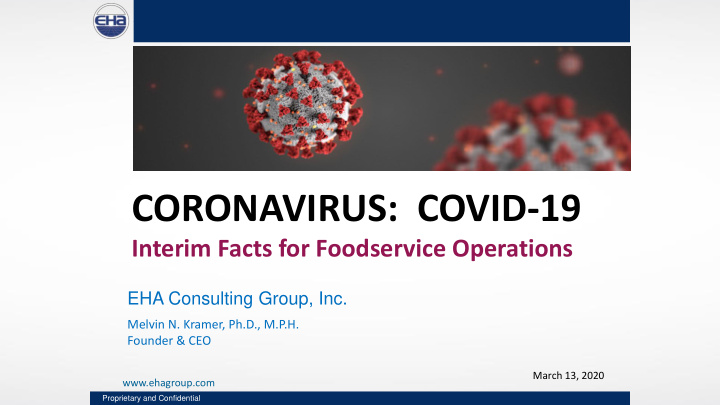



| 2 CORONAVIRUS: COVID-19 Interim Facts for Foodservice Operations EHA Consulting Group, Inc. Melvin N. Kramer, Ph.D., M.P.H. Founder & CEO March 13, 2020 www.ehagroup.com Proprietary and Confidential
Facts | 2 COVID -19 Facts • Total global cases =118,905 Deaths = 4,270 (3,036 from China) • Current total cases worldwide = 49,521 (pop – 7.8 billion) • % cases deemed mild = 43,475 (88%) Most cases are mild • % cases deemed severe = 6,046 (12%) • U.S. cases (pop- 331 million) = 975 Deaths 30 • 3.07% mortality rate in the U.S. • Caution is required but overall risk level is low. • NOTE: Since October 2019 in the U.S. >12,000 deaths due to the flu 2 Proprietary and Confidential Proprietary and Confidential
Facts | 3 Coronavirus • Large family of viruses that cause the common cold to more severe respiratory illness. (SARS and MERS) • COVID-19 is a novel (new) strain previously unseen. • Symptoms include fever, cough, trouble breathing. • Severe symptoms include pneumonia and acute respiratory syndrome which may cause death. • Can be transmitted between animals and humans • According to the WHO, coronaviruses may survive on surfaces for just a few hours to several days, although many factors will influence this, including surface material and weather. 3 Proprietary and Confidential Proprietary and Confidential
How is it spread…? | 2 | 4 • Coronavirus is easily spread through respiratory droplets. • Transmission can occur when an infected person coughs or sneezes and their droplets contact other’s mucous membranes (eyes, nose, mouth), either directly or from an infected surface. • No evidence COVID-19 is transmitted through food. • Transmission through fomites or inanimate surfaces with the virus to mucous membranes is why scrupulous handwashing and disinfection of these surfaces are imperative. 4 Proprietary and Confidential Proprietary and Confidential
Preventing the Spread in the Foodservice Environment… | 5 Guidance for Retail Foodservice • Complete prevention of transmission is not possible • Goal is to assure client and customers enhanced protocols are in place to make the environment as safe as possible. • Use of proper disinfectant https://www.epa.gov/sites/production/files/20203/documents/sars-cov-2-list_03-03- 2020.pdf • Increased frequency of service utensil cleaning and sanitizing • Increased frequency of cleaning of non-food contact surfaces. • Utilization of less self-service and more grab-n-go • Encourage handwashing as first option. Hand sanitizer acceptable but not as effective as frequent handwashing. • Foodhandler training – corporate policies regarding illness and reporting to work 5 Proprietary and Confidential Proprietary and Confidential
| 2 Preventing the Spread in the Foodservice Environment… | 6 Specific Guidance for Food Handler Confirmed Case Best Practices • The ill individual must be excluded from the work environment until cleared by physician to return. • Individuals working in close contact should be excluded from work for 14 days. • The unit should be temporarily closed. • Kitchen and general areas including locker room and restrooms should be cleaned and disinfected utilizing EPA approved disinfectant. • Assemble staff from other units, if possible, who were not in contact and being excluded, resume normal operations. • Resume operations 6 Proprietary and Confidential Proprietary and Confidential
Thank you. Please follow us on www.ehagroup.com where we will be posting updated and pertinent information 7 Proprietary and Confidential Proprietary and Confidential
Recommend
More recommend